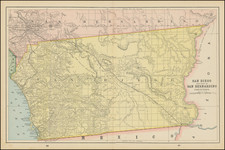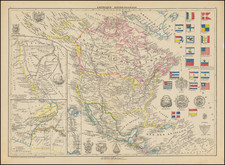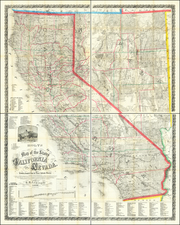How stands New San Diego?
Highly important early San Diego Letter, written by William H. Tiffany to William Heath Davis, dated June 30, 1850, discussing Tiffany's visit to San Diego, the need to construct a wharf in San Diego to further the "New Town" development, the sale of 1/2 of Rancho San Diego Island (Coronado, The Strand and North Island) to a new investor and other business related information, referencing a number of other important early California Residents.
Tiffany's letter was written less than 3 months after William Heath Davis's purchase of the 160 acres of land which would become New Town and just weeks before the commencement of construction on the Wharf in New Town, which cost Davis approximately $60,000.
This letter is one of the few extant source documents which provide a first hand account of Davis's New Town project, which had failed because of lack of water and an economic downturn in 1851.
William H. Tiffany was a Yale educated lawyer who arrived in California in June 1849. He served as counsel for several prominent early western investors, including William Heath Davis and Charles D. Poston of Boston.
Mailed from San Francisco to New San Diego June 30, 1850
Wm H Davis Esq.
My dear sir-
I was somewhat disappointed at not meeting with you after my sudden departure from New San Diego caused by the arrival of the steamer Chesapeake.
I shall not soon forget your cordial reception and the very many kind attentions which I rec'd during my visit from yourself and lady. We had a very fine run to this port which we reached Sunday morning. At Monterey we heard of the extensive conflagration which had consumed and laid in ruins so large a part of our city [San Francisco]. The particulars you will doubtless derive from the papers and from the advices of Mr. Lawton. I rejoice that you were so fortunate as to escape without material loss. The merchants do say that if those buildings which were left standing on Montgomery street had belonged to any other than yourself they would surely have been destroyed. However that may be I hope the same good fortune may ever attend you. Mr Grimes lost five buildings, mostly small and poorly adapted to their position. I think I can re-rent the premises so that his income therefrom will be nearly as much (ground rent) as it has been with the buildings upon them.
How stands New San Diego? Mr Lawton and myself called upon Capt. Simmons who informed us that he had sold one half of his interest in the island opposite San Diego [Rancho San Diego Island -- Coronado, The Strand & North Beach] to Mr. Aspinwall and that he intended to go down to examine the different localities which are suitable for the establishment of a coal depot. Till then we can make no arrangement for the building of a wharf. It needs but this, a new wharf, I think, to make the property at New San Diego exceedingly valuable. The old plan, however, of building a wharf ourselves is the safer course and preferable. A good wharf will accommodate all the steamers and by giving to them for a limited period free access thereto it will secure the place against all rivalry from other points. Then should any line of steamers wish a wharf for their exclusive use there will be plenty of room for their construction. So confident am I that some point on that harbor must ultimately become a place of commercial importance that while at the plaza I there also made a small investment purchasing some 3 or 4 lots. New San Diego will be the place if by any means we can divert the steamers from the plaza. Whether it can be done without the erection of a wharf is extremely doubtful.
Before leaving San Francisco for New San Diego Mr. Green of the firm of Mellus and Howard & Co. told me that the bark Burnham was on its way from San Pedro containing funds, part proceeds of the "Euphemias" Mexican voyage investment, to be divided between themselves, Mr Thompson and Mr. Grimes. Shortly after my departure the bark arrived bringing some $7000, all of which they claim as belonging to themselves and Mr. Thompson and have thus appropriated saying Mr. Grimes had no friends on board the bark and that you had the dividend belonging to Mr. Grimes. Now, I know not exactly the position of matters, but I do know that Mr. G made the investment and has received no dividend there from and I further know that neither Mr. Celis or any other person or persons of the Co. have the right to make " fish of one and flesh of another". I do know that it is not in consonance with law or justice that a man who has paid out $5000 should receive $2500 while he who has paid $10,000 should receive nothing. As agent for Mr. G I am bound to be watchful of his interests and I shall not be so unfaithful as to allow this to pass without a further knowledge of the right and principal by which this division was made.
I hope an adjustment of the matter may be made as becomes the high character and standing of the parties composing the company and I shall rely with confidence upon your aid in effecting an equitable arrangement.
I am not decided whether to serve an injunction upon Celis and bring suit for Mr. Gs interest in the funds already received or to take legal steps of a different character. I know the matter can be reached if a proper suit is instituted. I shall see Mr. Green tomorrow.
Give my best regards to Mrs. Davis, Miss Conception and the other members of your family whose acquaintance I formed at New San Diego.
I remain with high respect,
yours very truly,
Wm H. Tiffany
William Heath Davis
William Heath Davis was born in 1822, in Honolulu, son of Captain William Heath Davis, Sr., a Boston ship captain and pioneer of the Hawaii sandalwood trade, and Hannah Holmes Davis (1800-1847), a daughter of Oliver Holmes, Governor of Oahu.
Davis first visited California as a boy in 1831, then again in 1833 and 1838. The last time he joined his uncle as a store clerk in Monterey and Yerba Buena (now San Francisco). He started a business in San Francisco and became a prominent merchant and ship owner.
In 1847, Davis married María de Jesus, daughter of José Joaquin Estudillo, grantee of Rancho San Leandro, and granddaughter of José María Estudillo. In 1849, the couple moved to San Diego (Old Town), where Davis would shortly thereafter go on to be the original founder of New Town San Diego, an attempt to build a new community closer to San Diego Bay than the original Old Town San Diego, which was located below the Presidio of San Diego more than a mile from navigable water.
During a visit to San Diego in February 1850, the chief surveyor for the U. S. Boundary Commission, Andrew Belcher Gray, introduced himself to Davis. Gray pointed out to Davis what many San Diegans thought was obvious-the future of the town lay near the port, not inland at Old Town below Presidio Hill. The surveyor recognized Davis as a man with capital and suggested a partnership to establish a new town site.
The idea for New Town had originated with Lt. Andrew B. Gray, an American surveyor with the boundary commission which laid out the borders and boundaries of the new state of California. Gray's party camped near what is now H Street and he realized that this location near the natural harbor would be a much better location for a city. Davis agreed and recruited José Antonio Aguirre, Miguel Pedrorena, and William C. Ferrell as additional partners in the venture.
In March, 1850, he had purchased 160 acres of land and, with his four partners, laid out the city and built a large wharf and warehouse. The group purchased a shipload of pre-cut wooden houses, wich were shipped to San Diego from Portland, Maine. Davis invested $60,000 for construction of a wharf and warehouse to attract ships to the new site. Land donated to the military for an Army barracks completed the nucleus of "New Town" San Diego.
A small community grew around the plaza of Pantoja Park, at Fourth (G Street) and India. The nearby San Diego Barracks gave the town a steady population of soldiers, who happily patronized the billiard room and saloon at Davis' new hotel, the Pantoja House. The arrival of newspaper publisher John Judson Ames was a coup for Davis; Ames' Herald, San Diego's first newspaper, began from an office above store in New Town in May 1851.
The local residents referred to the project as New Town, Graytown (after Lt. Gray), and "Davis's Folly". The venture did not do well due to a lack of fresh water and hostility from the established settlements at Old Town and La Playa.
An economic depression in 1851 put an end to their plans and New Town rapidly declined until the arrival of Alonzo Horton, in 1867, who built a new subdivision just to the east of Davis's plot, which became a success.
Davis later wrote a memoir which was of great value to historians in understanding the early years of California and San Diego.









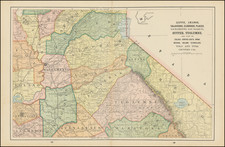
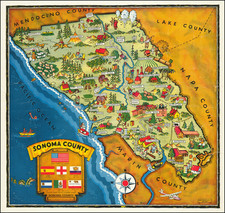
![[Appointment of Ben E.S. Ely as Notary Public for Napa County, California - September 26, 1861]](https://storage.googleapis.com/raremaps/img/small/93309.jpg)
